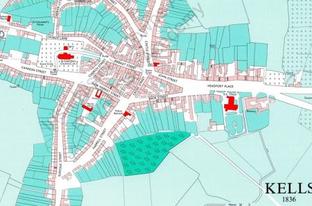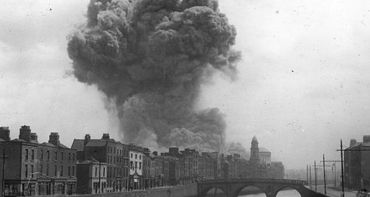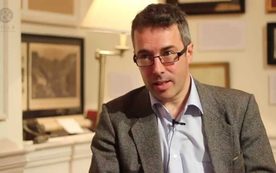- The Register of the Parish of Saint Peter and Saint Kevin 1669-1761, published in 1911 by William Pollard & Co. Ltd. – Christening, marriage, and burial registers from the first two surviving parish registers. This publication is volume 9 in the Parish Register Society of Dublin series.
- The Registers of the Church of St. Michan 1636-1700, published in 1909 by Alexander Thom & Co. – These registers from St. Michan are some of the oldest surviving Irish parish records. Taken from four different parish registers, this publication contains christening, marriage, and burial records. This publication is part of the Parish Register Society of Dublin series, comprising volumes 2, 3, and 7.
- Marriage Entries from the Registers of the Parishes St. Andrew, St. Anne, St. Audoen, & St. Bride 1632-1800, published in 1913 by William Pollard & Co. Ltd. – This publication, comprising volume 11 of the Parish Register Society of Dublin series, includes marriage records and appendixes of occupations and places contained within this volume. This contains some of the oldest surviving Irish parish records and the only surviving records from the Parish of St. Bride. Some records related to famous individuals can be found within its pages, like the marriage record for Wolfe Tone, the father of Irish republicanism and co-founder of the Society of United Irishmen.
- The Register of St. Nicholas Without 1694-1739, published 1912 by William Pollard & Co. Ltd. – Volume 10 of the Parish Register Society of Dublin contains some of the earliest surviving registers for baptisms, marriages, and deaths from the Church of St. Nicholas Without. Worship services were held in the north transept of the Cathedral Church of St. Patrick and burials took place in the Cabbage Garden adjacent the cathedral.
- Marriage Entries in the Registers of the Parishes of S. Marie, S. Luke, S. Catherine and S. Werburgh 1627-1800, published in 1915 by William Pollard and Co. Ltd. – Part of the Parish Register Society of Dublin, this publication contains some of the most complete marriage records: where entries were missing, the editor supplemented the entries with information from other sources, such as the Dublin Grant Book and Prerogative Grant Book. Marriage entries span the following years: St. Marie (1697-1800), St. Luke (1716-1800), St. Catherine (1715-1800), and St. Werburgh (1704-1800).
- The Registers of St. John the Evangelist 1619-1699, published in 1906 by Alexander Thom & Co. – This publication is the first volume of the Parish Register Society of Dublin series. Registers from St. John the Evangelist are the earliest known surviving Irish registers. They contain all the christening, marriage, and burial records from the first two folio parchment registers for St. John’s parish. Also contained within this publication are entries from the Churchwardens’ Books, lists of parish cess (church tax) payers (for years 1621, 1646, 1687), and the English who fled to the parish due to the Irish Rebellion of 1641.
- The Registers of St. Catherine 1636-1715, published in 1908 by William Pollard & Co. Ltd. – Volume 5 of the Parish Register Society of Dublin, contains the parish registers of St. Catherine, which are some of the oldest in Ireland, likely dating back to the Canon of 1634, which instructed Irish parishes and chapels to keep accounts of their christenings, marriages, and burials: ‘In every parish church and chapel within this realm shall be provided one parchment book at the charge of the parish, wherein shall be written the day and year of every christening, wedding, and burial’. This volume is divided into two chapters, the first being extracts from the register of St. Catherine and St. James, Dublin, 1636-1687 and the second being the register of St. Catherine, Dublin, 1679-1715. Also included are extracts from the Subsidy Roll, City of Dublin, 1637 and from Hearth Money Roll, City of Dublin, 1666-67, as well as indexes for persons and places.
- The Registers of St. Patrick 1677-1800, published in 1907 by Alexander Thom & Co. – This publication is volume 2 of the Parish Register Society of Dublin and is largely comprised of baptism and burial records. Included are the burial records are some of Dublin’s most distinguished citizens, such as Jonathan Swift and several archbishops.
- North Strand, Clonliffe Road & Summerhill District Census Index 1901, published in 1998 by the Genealogical Society of Ireland – This index was compiled by Marie Keogh and pertains to the District Electoral Division No 38. This district covers the land surrounded by the North Strand, Clonliffe Road, and Summerhill in northern Dublin. The index holds more than 3,500 names and addresses. The 1901 census was taken on 31 March 1901 and was the first to cover the whole of Ireland.
- Booterstown School Registers 1862-1872 & 1891-1939, published in 1998 by the Genealogical Society of Ireland – This publication was compiled by Frieda Carroll. These school registers may be able to give you details pertaining to why your ancestor left school or where they went to after Booterstown School. Earlier records were more detailed in this regard. Later records will usually only indicate where a child came from.
- Whitelaw’s Census Street Index Dublin City 1798, published in 1998 by the Genealogical Society of Ireland – This index was extracted by Sean Magee from Whitelaw’s Census, being an account of the 1798 census of Dublin. It is broken up into two parts: an alphabetical index by street and an alphabetical index by parish.
- Petitioners Against Closure of Kill O’ The Grange Cemetery 1864, published in 1998 by the Genealogical Society of Ireland – This publication was created by Annette McDonnell. You can read the full text of the petition and see the names of the petitioners both in order of their inscription and alphabetically. Kill O’ The Grange Cemetery is an ancient burial ground surrounding the ruins of one of the earliest Christian churches, St. Fintans.
- Baldoyle Census Extracts 1901, published in 1998 by the Genealogical Society of Ireland – This publication was compiled by Marie Keogh. Baldoyle was part of the former County Dublin and was a maritime parish in 1901. It was 1,236 acres in size, with 27 of those acres in the village. For the census, the area was broken up into five areas.
- Glasthule, Harold (Boys) School Registers 1904-1948, published in 1998 by the Genealogical Society of Ireland – This publication was compiled by Eithne Guilfoyle. Included are the names of boys, sorted alphabetically, from two school registers of pupils entering the Boys’ School from 1904 to 1948.
- Dalkey, St Patrick’s School Registers 1894-1970, published in 1999 by the Genealogical Society of Ireland – Annette McDonnell compiled this publication. Since 1888, the school’s teacher was Miss Anna Maria Kidd. St Patrick’s would remain a one-teacher school until the 1950s. As enrollment grew at the start of the 1960s, the school was subsequently enlarged. The National Archives holds lists of students from 1894 up until 1970 – one register for boys and one for girls. Admission dates, addresses, parents’ names, and religious denominations were also recorded with the students’ names.
- Blackrock Urban District Area Census Index 1901, published in 2000 by the Genealogical Society of Ireland – This index was compiled by Marie Keogh. The index is not an exhaustive list of everyone in each family in the census. However, the inclusion of addresses and other key fields should aid in tracing any ancestors who lived in the area at that time.
- Howth, Sutton, Kilbarrack & Baldoyle Census Index 1901, published in 2002 by the Genealogical Society of Ireland – This index was compiled by Marie Keogh. Broken up into two parts, the first index covers the 1901 census for Howth, Sutton, and Kilbarrack, and the second index covers the 1901 census for Baldoyle. This publication includes extracts from Lewis’s Topographical Dictionary 1837 and Thom’s Directory 1902, as well as county and country codes and explanations of column headings.
- Dun Laoghaire, Rathdown Memorial Inscriptions, published in 2008 by the Genealogical Society of Ireland – The memorial inscriptions in this collection pertain to the smaller graveyards in the Dun Laoghaire Rathdown County area.
|
0 Comments
 The Reading Room of the National Archives will close at 16:00 on Wednesday, 26 October 2016 in order to prepare for the hosting of an official event. Findmy past add Irish Genealogical Society journals to their periodical Index
 9/10/16 National Archives progresses new public service records management plan Seminar to consider challenges of preserving electronic records The National Archives will this Friday (October 21st) hold a seminar for civil and public servants to raise awareness of the value and importance of good records management. It will focus on the effective creation and management of public records and in particular, how to deal with the related emerging issues with regard to electronic records. Speaking today the Director of the National Archives John Mc Donough said: “The bulk of records being generated today are done so in electronic format and here at the National Archives we are aware of a pressing need for guidance to be provided to Government departments to ensure the long term preservation of the public record in this format. “Together with the Department of Public Expenditure and Reform, we have initiated a dialogue to develop and progress a new public service records management plan. It will bring clarity and confidence to public servants in their management of records and ensure that important records are preserved for the public. “This plan comes at a time of positive growth for the National Archives. Last week as part of Budget 2017, Minister Humphreys announced an increase in day to day funding of almost 20% for the Archives, which will ensure that our strategies can continue to be actively progressed through this Decade of Centenaries. These strategies include advancing the development of the records management plan and a number of digital initiatives. “In addition, work is continuing on our major redevelopment plan, which will significantly increase the volume of archival storage on the Bishop Street site in Dublin 8. Researchers will benefit from the recently reopened Reading Room which has been upgraded with new lighting and air handling facilities to offer a more comfortable environment for those using this facility and to protect the records themselves. “As we move towards 2022, and the anniversary of the destruction of the Public Records Office of Ireland, we welcome this on-going commitment by the Minister and her Department to the archival record, and the development of new technologies and approaches to ensuring its preservation and continued accessibility in Bishop Street and online.” ENDS  Five Irish Historic Towns Atlases of monastic origin now available freely online to read and download. Following from the success of our pilot Irish Historic Towns Atlas (IHTA) Kilkenny online, IHTA atlases nos 1 to 25 will be made available freely online over the coming months. The cover, general abbreviations, select bibliography, essay, topographical information, maps 1, 2 and 3 as well as a growth map, will be freely available and word searchable to read online or to download. As the nature of the project is comparative urban studies, the first batch to be released are the towns of monastic origins: IHTA no. 1 Kildare by J.H. Andrews, IHTA no. 4 Kells by Anngret Simms, IHTA no. 8 Downpatrick by R.H. Buchanan and Anthony Wilson, IHTA no. 18 Armagh by Catherine McCullough and W.H. Crawford and IHTA no. 20 Tuam by J.A. Claffey. It also comes with an excerpt on Irish towns of monastic origin from Reading the maps: a guide to the Irish Historic Towns Atlas by Jacinta Prunty and H.B. Clarke (Dublin, Royal Irish Academy, 2011). Read more Seminar and Award Honours Former Church of Ireland Librarian and Archivist, Dr Ray Refaussé The fact that around 90 people turned up on a wet Saturday morning for a special event to honour the career of Dr Raymond (Ray) Refaussé (who retired from the RCB Library earlier this year) spoke volumes about the high esteem in which he is held not only within Church of Ireland circles but the wider archival profession in Ireland. Continue reading  Rube Goldberg genealogy by John Grenham I’m a great fan of the eccentric machines cartooned by Rube Goldberg in the US and Heath Robinson over here. They are wonderful parodies of the supposed benefits of automation, the little man blowing a raspberry at the pomp and self-importance of the Machine Age. How the wizard was writtenThey also sum up pretty accurately a fair amount of my working life, at least on the software development side. Most of it still feels like having to stand on my head in order to comb my hair. But there is a genuine satisfaction in seeing one of my software contraptions chug into life like a piece of homemade clockwork. The reason for going on about this is that I’ve finally put up a step-by-step wizard on this site, taking whatever someone knows about their Irish ancestor and producing an unthreatening summary of sources and links to get research going. continue reading  Steven Smyrl writing in the Irish Times. When the dust had settled over the ruins of Sackville Street at the end of Easter Week 1916, down at the Four Courts, the deputy keeper of the records, MJ McEnery, found that despite the building being occupied and its contents disturbed, the Public Record Office of Ireland had escaped virtually unscathed. Remarkably, the only irreparable damage was the loss of one will, that of John Watson, a private in the Royal Irish Regiment, who died in 1884. However, the occupation six years later would not have the same happy outcome. On June 30th, 1922, the Civil War combatants destroyed a thousand years of documents, tracing the history of Ireland and its people, in one huge, cataclysmic explosion. In one great calamity, parish registers, wills, court records, letter books, deeds, census returns, marriage licences, land rentals, minute books and proclamations all rained down across Dublin city and county like so much confetti. Continue reading  New book by Turtle Bunbury Carlow author Turtle Bunbury has just seen the publication of his latest work – a collection of tales of characters and events from the year 1847. The book's full title is '1847 - A Chronicle of Genius, Generosity & Savagery' Read more  Roadmap of the Promised Land How best to use all the new records we have at IrishGenealogy.ie? They consist of:
Read more |
Blog RollThings that happen. Archives
October 2018
Categories |
 RSS Feed
RSS Feed